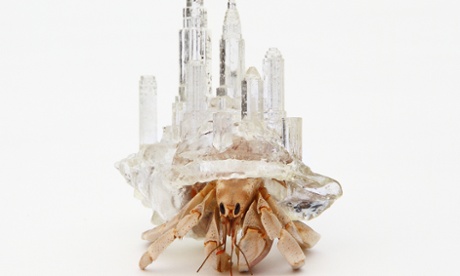
House-hunting might be hard for humans, but next time you're trawling the desolate pages of Rightmove, spare a thought for the poor hermit crab. Born without a shell to protect their vulnerable abdomens, their lives are a constant search for the next house, as they grow out of successive spiral lodgings. And for these squatters of the seabed, it's a matter of life or death: if they can't retract entirely within their shell, they're more likely to be eaten. It makes property guardianship seem like an easy ride.
Just like the desperate scrum of property viewing, on the rare occasions when a new shell becomes available, hermit crabs flock in their droves to the coveted carapace. In a curious model of hand-me-down housing, the biggest of the pack forces its way into the empty shell, while the others form a frenzied conga line from largest to smallest, waiting to scramble into the cast-off from the one in front.
But things aren't always so civilised. Groups are known to gang up and forcibly evict fellow hermits from particularly desirable shells, while others fight to the death over deluxe homes. Mimicking our own housing crisis, there is a global rise in homeless crabs: thanks to our lust for shell-collecting, there simply aren't enough to go round.
But help may be at hand thanks to Japanese artist Aki Inomata, who has branched out into creating bespoke architecture for arthropods. From the soaring skyline of New York to the teetering townhouses of Honfleur, from the clustered hill-town of Santorini to the grand beaux arts blocks of Paris, hermits are now spoilt for choice.
Using a CT scanner, Inomata constructed a 3D model of an unoccupied snail shell, complete with the spiralling apex inside – a crucial feature that allows the crab to grip on with the pointed end of its body – then added a range of architectural features, before printing the shells out in transparent plastic. She then left the assembled jewel-like follies for her lucky pet crab to choose from. It turned out that the ultimate favourite, into which the crab wriggled and refused to leave, was a shell modelled on the Moroccan mud city of Ait-Ben-Haddou.
Inomata's attention turned to the transitory habits of hermit crabs after the change in ownership of the French embassy in Tokyo. “I overheard that the land of the former French embassy in Japan had been French until October 2009,” she writes. “Then it was to become Japanese for the following 50 years, and then returned to France. This concept made me think of hermit crabs, which change their shells. The same piece of land is peacefully transferred from one country to the other … Though the body of the hermit crab is the same, according to the shell it is wearing, its appearance changes completely.”
With the rise in home 3D-printing – along with a shell-printing initiative launched by Makerbot last year – beach-combing might never be the same again. Next time you're strolling the shores, you may just glimpse a scuttling Moroccan hillfort.

